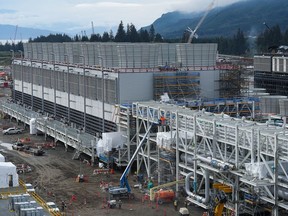
Article content
Pierre Poilievre’s Ax the Tax (carbon) campaign is a spectacular success. But the Conservative Party needs its own plan to reduce fossil fuel emissions. Paradoxically, it is a fossil fuel that provides the answer.
Canada’s rich endowment of natural gas offers us the opportunity to reduce global emissions and also rescue a Canadian economy devastated by the Liberal government.
Advertisement 2
Article content
Article content
As? Exporting liquefied natural gas (LNG) to China, Japan, South Korea and other coal-dependent Asia-Pacific countries. Switching from coal to natural gas reduces CO2 emissions by 50 percent while eliminating toxic compounds and lung-clogging particles that shorten the lives of millions of people in Asian cities.
A November 2022 study by respected consulting firm Wood Mackenzie concluded that:
· “Canada is well positioned geographically: LNG from Western Canada is much closer to Asia compared to LNG from the US Gulf Coast, which must be shipped to Asia via the Panama Canal.”
· “Canada’s LNG would be cost-competitive for Northeast Asian importers.”
· “Asia will not be able to produce enough natural gas domestically to meet its growing demand. “With its high environmental standards and management, Canada would be a great partner to fill the gap in LNG demand.”
In 2010, there were more than 20 LNG projects in the pipeline in British Columbia, representing an investment in the hundreds of billions. These include ExxonMobil’s $25 billion project on Canada’s West Coast, Chinese company CNOOC’s $36 billion Aurora project, Malaysian firm Petronas’ Pacific Northwest project, $36 billion, and the $31 billion Kitimat LNG Canada project, led by Shell.
Article content
Advertisement 3
Article content
After a decade of trying to navigate Canada’s byzantine regulatory process, LNG Canada is the only one left standing. And it succeeded only because South African project leader Andy Calitz refused to give up.
After five years of construction, Canada’s LNG terminal is nearing completion, with the first ship scheduled to set sail for China in mid-2025. The $31 billion invested in the Kitimat liquefaction plant is just a component of Canada’s first LNG export project. TC Energy Corp’s $15 billion Coastal GasLink will transport natural gas from gas fields in northeastern British Columbia to the Kitimat terminal.
The economic benefits are innumerable. British Columbia’s natural gas royalties are projected to double, from $700 million in 2024 to $1.4 billion in 2027. There are significant employment and business opportunities for First Nations, including Haisla’s 50 per cent share Marine in a $500 million contract.
That’s just Phase 1 of LNG Canada. Construction of another 14 million tonnes per year of LNG Canada Phase 2 is scheduled to begin in 2026, with delivery in 2032. A Canada Action report estimates that completion of both LNG Canada phases alone is equivalent to eliminating 18 million cars off Canadian roads.
Advertisement 4
Article content
A major barrier for LNG project sponsors has been Canadian regulators’ focus on the project’s internal emissions, which are minuscule compared to the global emissions reductions they make possible. Instead of allowing the project to use on-site natural gas-powered electricity generation, regulators insisted that LNG Canada use zero-emission hydropower. Having BC Hydro build a new dam and an expensive new transmission line significantly delayed the project.
Ahead of COP24, the United Nations Climate Change Conference in Katowice, Poland, in 2018, federal Conservatives urged Canadian delegation leaders to propose that national emissions reductions include reductions in LNG displacement of coal exported. Our Prime Minister and his team of anti-fossil fuel green zealots rejected this advice. A new government that encourages LNG projects could well see a return of ExxonMobil, CNOOC and Petronas projects, rejected by government intransigence.
As an alternative to a carbon tax, LNG exports not only do better in reducing emissions, but also generate tens of billions of dollars in economic benefits for a beleaguered Canadian private sector.
Increasing LNG exports is a far superior environmental alternative to the economically destructive and politically divisive carbon tax, and would help reverse the decline of a proud, prosperous nation into a debt-ridden, unproductive, government-dominated basket case.
Gwyn Morgan is the former executive vice president of Encana and now a freelance energy writer.
Article content
